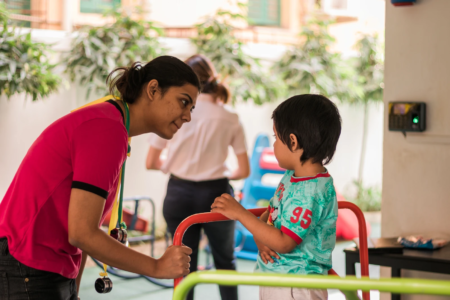After understanding the dangers of extreme weight loss trends among teenage girls, the next step is finding solutions. How can we help them break free from the cycle of harmful dieting, self-doubt, and body shaming? The answer lies in shifting the focus from unrealistic beauty standards to health, strength, and self-acceptance. Teenage girls do not need starvation, toxic diet trends, or shame to feel beautiful—they need the right guidance, a support system, and a mindset that values well-being over a number on the scale. 1. Education: Teaching the Truth About Health and Fitness The first step in solving this crisis is education—teaching girls what real health means. Schools, parents, and even social media influencers need to spread the right message: Understanding Real Nutrition Instead of fearing food, teenage girls should learn how it fuels their bodies. A well-balanced diet includes proteins, healthy fats, complex carbohydrates, and essential vitamins—NOT extreme calorie restrictions. Educating them on the importance of real nutrition can help them develop a healthy relationship with food. Debunking Social Media Myths Schools and organizations should introduce workshops that expose the truth behind heavily edited Instagram posts, misleading “before-and-after” transformations, and toxic weight loss trends. Girls need to know that many influencers promote diet products for money, not because they work. Encouraging Mindful Eating Instead of labeling foods as “good” or “bad,” teaching mindful eating—listening to hunger cues, eating slowly, and enjoying food without guilt—can create a lifelong healthy habit. 2. Promoting Healthy and Sustainable Weight Management For those who do want to lose weight, it should be done in a way that benefits their overall health, not just their appearance. Balanced Exercise, Not Punishment Exercise should never feel like a punishment for eating. Instead of forcing themselves into extreme workouts, girls should be encouraged to find activities they genuinely enjoy—dancing, yoga, swimming, cycling, or even just walking outdoors. Movement should bring happiness, not exhaustion. Proper Hydration Without Extremes Hydration is essential, but excessive water intake, especially hot water diets, can be dangerous. Teaching girls to drink water in a balanced way and including hydrating foods like fruits and vegetables can prevent dehydration and its harmful effects. Smart, Safe Weight Loss (If Needed) If a teenager genuinely needs to lose weight for health reasons, they should do so under professional guidance—nutritionists and dietitians can create safe, effective meal plans rather than relying on social media fads. 3. Mental Health Support: Healing from the Inside Out The biggest battle isn’t in the body—it’s in the mind. Many teenage girls struggle with self-esteem, anxiety, and body image issues. Providing them with the right emotional support can help them escape the toxic cycle of unhealthy weight loss. Encouraging Open Conversations Parents and teachers should create a safe space where girls feel comfortable discussing their insecurities without judgment. A simple conversation can prevent someone from falling into dangerous habits. Therapy and Counseling Sometimes, professional help is needed. If a girl is struggling with extreme dieting, eating disorders, or depression, therapy can help her rebuild a positive self-image. Schools should offer mental health resources, and parents should seek support if they notice concerning behaviors. Self-love and Body Positivity Instead of constantly chasing an unrealistic “perfect” body, teenage girls should learn to appreciate their uniqueness. Promoting body diversity in media, supporting brands that showcase real women, and engaging in self-love activities (like journaling, positive affirmations, or gratitude lists) can help shift their mindset. 4. Social Media Reform: Changing the Narrative Social media plays a major role in shaping how young girls view themselves. It’s time to demand change. Stricter Regulations on Harmful Content Platforms should take responsibility by restricting content that promotes extreme diets, unsafe weight loss methods, and body shaming. Following Positive Influences Encouraging girls to follow fitness experts, nutritionists, and influencers who promote health, strength, and self-love—rather than unrealistic body goals—can change their entire outlook. Spreading Awareness Teens, parents, and educators should work together to call out harmful trends and spread awareness about safe and healthy practices. The more people speak up, the more impact it will have. Final Thoughts: A Future Where Girls Feel Free The solution to this crisis isn’t about banning weight loss but about redefining it. Teenage girls should feel free to take care of their bodies without falling into dangerous traps. They should know that they are not defined by their size but by their health, strength, and confidence. It’s time to build a future where young girls grow up loving themselves—not starving themselves. A future where weight loss is about feeling good, not suffering. And most importantly, a future where every girl knows: She is enough. Just as she is. Keep reading foramz for your daily dose of emotional support.
In the pursuit of beauty, how much are we willing to risk? For one young girl, the price was her life. Sreenanda, a bright and ambitious teenager from Kerala, was like any other girl her age full of dreams and aspirations. But in today’s world, where social media dictates beauty standards, she found herself trapped in an invisible cage. The pressure to look slim was overwhelming. Every day, she was flooded with images of influencers and celebrities with “perfect” bodies. She wanted to be like them, to fit in, to be admired. And so, she embarked on a dangerous journey one that would ultimately take her life. The Deadly Obsession with Thinness In Koothuparamba, Kerala, the heartbreaking story of 18-year-old M. Sreenanda has cast a dark light on the perilous paths some teenagers tread in pursuit of societal beauty standards. A first-year undergraduate student at Pazhassi Raja NSS College, Mattannur, Sreenanda’s life was in danger due to severe health complications arising from extreme dieting practices she adopted after following online weight-loss plans. Sreenanda’s struggle began with an intense fear of weight gain, an emotion faced by many adolescents struggling with body image issues. She came across a weight loss trend online that promised “quick and effortless results.” It was called the hot water diet a method where one drinks excessive amounts of hot water to “burn fat” and suppress appetite. Online sources, unverified fitness influencers, and even peers claimed it was effective. Desperate to shed a few pounds, she believed it. The Silent Battle Within Medical professionals suspected that Sreenanda suffered from anorexia nervosa, a severe eating disorder characterized by an obsessive fear of gaining weight and a distorted body image. Individuals with this condition often perceive themselves as overweight despite being underweight and resort to extreme measures to avoid eating. At first, it seemed harmless. She replaced meals with hot water, thinking she was on the right path. But soon, her body began to suffer. Drinking excessive hot water flushed out essential nutrients and electrolytes from her system, leading to severe dehydration. Her energy levels dropped, and she started feeling dizzy, weak, and nauseous. Yet, she ignored the warning signs. The obsession with weight loss had clouded her judgment. Her family noticed changes. She was no longer her energetic self. She felt tired all the time, often skipping meals, and complained about nausea. But she reassured everyone, saying she was fine trying to “stay fit.” The Collapse One evening, Sreenanda fainted at home. Her parents rushed her to the hospital, unaware of what was happening to their daughter. The doctors were shocked her body was severely dehydrated, her sodium levels had dropped dangerously low, and her organs were under immense stress. The so-called “hot water diet” had drained her body of essential minerals, making it impossible for her heart to function properly. Approximately five months before her death, she was taken to a hospital where doctors advised her family to ensure she ate properly and sought psychiatric consultation. However, her health continued to decline. Two months before her passing, she was taken to Kozhikode Medical College for tests, where doctors reiterated the need for nutritional care and psychiatric support. The Final Days Two weeks before her death, Sreenanda’s condition worsened significantly. Her blood sugar dropped to dangerously low levels, and she experienced severe breathing difficulties, leading to her immediate admission to Co-operative Hospital in Thalassery. A consultant physician at the hospital reported that upon admission, she was critically underweight at just 24 kg, with extremely low sugar levels, sodium, and blood pressure. Despite being placed on ventilator support, her condition did not improve, and she succumbed to her illness. Despite all efforts, Sreenanda could not be saved. She passed away, leaving her family in unbearable pain. A young life was lost, not due to an illness or an accident, but because of a dangerous beauty standard that made her believe she had to starve herself to be accepted. Sreenanda’s death is not just a personal tragedy it is a reflection of a larger social issue. Who should take responsibility? Social media influencers promoting dangerous diets without medical backing? Society, for setting impossible beauty standards? The lack of awareness about the risks of extreme dieting? The answer is all of them. Teenage girls today are under immense pressure to be thin. Their self-worth is measured in inches and numbers on a scale. Instead of being taught self-love and body acceptance, they are being pushed towards unrealistic goals. The hot water diet is just one example there are countless others: starvation diets, detox drinks, appetite suppressant pills, and unregulated weight-loss supplements. The tragedy is that many of these diets are not just unhealthy they are life-threatening. Sreenanda’s death should be a wake-up call. If we don’t act now, more lives will be lost to this toxic culture of body shaming and unhealthy beauty standards. A Call for Change Sreenanda’s story must not be forgotten. Her death should serve as a warning to every teenager, every parent, and every society that prioritizes appearance over health. We need to educate young girls about the dangers of extreme dieting. We need stricter regulations on influencers promoting unsafe weight-loss methods. And most importantly, we need to redefine beauty not as thinness, but as health and confidence. No child should have to die just to feel accepted. No family should have to lose a loved one to a senseless trend. The cost of these dangerous fads is too high. Sreenanda’s life was priceless but it was taken away by a false promise of beauty.
The increasing number of murders and violent crimes within marriages is a disturbing trend that raises serious concerns about the health of relationships, mental well-being, and societal influences. Cases of husbands killing wives or wives killing husbands have become more frequent, pointing to deep-rooted issues such as domestic violence, financial stress, infidelity, and psychological disorders. This article explores the core reasons behind such crimes and suggests measures to prevent them. Impacts of Domestic Murders Solutions to Prevent Domestic Murders The increasing cases of domestic murders highlight the urgent need for societal intervention, legal reforms, and mental health awareness. While no single solution can eliminate these tragedies, a collective effort from individuals, families, communities, and governments can significantly reduce such incidents. Promoting awareness, strengthening legal frameworks, and fostering a culture of respect and open communication can help prevent the loss of innocent lives and create a safer society for all. To keep reading, subscribe to foramz.com
While the challenges posed by obesity are immense, they are not insurmountable. The journey toward a healthier life is deeply personal, often emotional, and filled with ups and downs. Yet, with compassion, perseverance, and support, obesity can be addressed not just through weight loss but by healing from within. It’s time to embrace this journey with kindness toward ourselves and those we love. 1. Shifting the Mindset: From Shame to Self-Love The first step in overcoming obesity begins not with the body, but the mind. Society has long painted obesity in a negative light, often blaming individuals for their condition. This stigma only pushes people deeper into isolation and emotional eating. To combat obesity, we must shift the conversation from blame to understanding. Accepting oneself is not the same as giving up; it is acknowledging where we are while believing in the possibility of change. Individuals must learn to love their bodies enough to take care of them, not punish them. Support groups, therapy, or even heartfelt conversations with a loved one can spark the light of transformation. Emotional healing lays the groundwork for physical healing. 2. Mindful and Nourishing Eating Habits Crash diets and miracle pills often promise fast results, but they rarely last and can leave individuals feeling broken when they fail. Instead of focusing solely on restriction, individuals should be encouraged to build a positive relationship with food seeing it as nourishment, not punishment or reward. Simple changes like choosing whole foods, increasing fiber intake, cutting back on added sugars, and staying hydrated can make a lasting impact. Planning balanced meals, eating slowly, and recognizing hunger and fullness cues teach mindful eating. Consulting a nutritionist or dietitian can provide tailored guidance that respects cultural, emotional, and physical needs. It’s not about eating less—it’s about eating right, with respect for the body’s needs. 3. Physical Activity That Feels Good Exercise should not be a punishment for eating or a chore to dread. The key lies in discovering physical activities that bring joy be it dancing, swimming, yoga, gardening, or simply walking while listening to music or a podcast. Moving the body becomes easier when it’s something to look forward to. Starting small is not failure—it’s strength. Ten minutes of daily movement can build up to a routine that transforms health, improves mood, and reignites hope. For those with mobility issues or chronic pain, adaptive exercises exist and can be life-changing when approached with patience. 4. Building a Circle of Support No one should have to face obesity alone. Encouragement from family, friends, or even strangers on the same journey can be life-affirming. Online communities, support groups, and wellness programs offer motivation, tips, and most importantly, the reminder that someone else understands. Healthcare professionals doctors, psychologists, dietitians, and fitness experts can be allies when treated as partners in healing, not judges. The right team can guide with expertise and empathy. 5. Addressing Deeper Roots Obesity often stems from emotional trauma, stress, childhood habits, or deep-rooted insecurities. Therapy and counseling are crucial tools in understanding and overcoming these issues. Healing the heart clears the path to healing the body. When people stop using food to numb pain and instead find healthier outlets—writing, art, connection, faith—they free themselves from cycles of guilt and shame. Every emotional victory counts. 6. Creating a Healthier Environment Communities and governments also play a role. Ensuring access to affordable, healthy food; safe spaces to walk or exercise; and mental health resources makes a huge difference. Employers should support wellness programs, and schools must teach body positivity and balanced nutrition from a young age. Obesity is not just an individual issue it’s a shared responsibility. Healing from obesity is possible, and every step taken with love and courage is a step toward freedom. You are not alone. And you are worth the journey.
India, traditionally known for its strong family values and long-lasting marriages, is witnessing a gradual yet notable rise in divorce rates. While the country still maintains a relatively low divorce rate compared to many Western nations, the increase in separations reflects a society in transition where evolving mindsets, growing individualism, and increased awareness are reshaping the institution of marriage. Breaking the Traditional Mold For generations, marriage in India was seen as a lifelong bond, often upheld even in the face of unhappiness or conflict. However, this perception is shifting. Today, personal well-being and emotional fulfillment are becoming more important than merely preserving the sanctity of marriage. Many individuals, particularly in urban areas, are no longer willing to stay in relationships that lack compatibility or respect. Empowered Women, Empowered Choices One of the most significant factors contributing to the rise in divorce cases is the empowerment of women. With better access to education, financial independence, and an increasing awareness of their legal rights, more women are now in a position to make decisions that prioritize their mental, emotional, and physical well-being — even if it means walking away from a marriage. The Role of Legal Reforms Legal reforms have also played a pivotal role. The introduction and simplification of procedures like mutual consent divorce have made it easier for couples to part ways amicably. The judicial system, though still burdened, is slowly becoming more accessible to the common person. Urban Stress and Relationship Strain The pressures of urban living long working hours, stressful jobs, financial instability, and limited quality time with partners often lead to emotional disconnection. The fast-paced lifestyle in cities has been linked to growing dissatisfaction within marriages, further contributing to the increase in divorce filings. Love Marriages Under Pressure Interestingly, a rising number of divorces are being reported from love marriages, where couples choose their own partners. Unlike arranged marriages that often come with strong family backing and societal expectations, love marriages may lack that external cushion, which sometimes leads to friction, especially when the honeymoon phase fades and real-life challenges set in. Urban vs. Rural Divide While divorce rates are increasing across the country, the trend is more evident in urban centers, where liberal social norms and anonymity allow individuals to make bold decisions with less fear of societal judgment. In contrast, rural areas, where conservative values still dominate, witness fewer divorces, though the numbers are slowly climbing there as well. Regional Differences Certain regions, particularly in the North-East, such as Mizoram, report higher divorce rates. Cultural factors, local customs, and differing attitudes toward marriage and separation could be influencing these statistics. Common Grounds for Divorce Couples cite a range of reasons for ending their marriages. These include incompatibility, infidelity, domestic abuse, emotional neglect, and financial troubles. The rise of mental health awareness has also led people to recognize and act upon toxic or unfulfilling relationships. Who’s Initiating the Divorce? Interestingly, more and more women are initiating divorce proceedings. This trend reflects not only changing gender dynamics but also the growing confidence among women to seek freedom from unhappy marriages without the stigma that was once heavily attached to divorce. The increasing divorce rates in India are not merely a sign of broken marriages, they’re a sign of transformation. As society progresses, values evolve, and individuals assert their rights and choices, it’s only natural that the way we view marriage and relationships also changes. While this shift brings its own challenges, it also marks a move toward a more open, honest, and emotionally aware society where people are learning to prioritize their happiness, even if it means walking away. To keep reading, subscribe to foramz.com
April is here, bringing with it the recognition of Autism Acceptance Month not just a time to spread awareness but a call for genuine acceptance, inclusion, and respect. For years, autism has been talked about in hushed tones, often misunderstood and misrepresented. But today, the conversation is changing, shifting from simply knowing about autism to truly embracing autistic individuals for who they are. What is Autism? Autism, or Autism Spectrum Disorder (ASD), is a developmental condition that affects how a person perceives the world and interacts with others. But there’s no single way autism “looks.” It’s a spectrum, meaning every autistic individual experiences it differently. Some may struggle with verbal communication, while others may be highly articulate but find social interactions overwhelming. Some might have intense passions for specific interests, while others may have sensory sensitivities that make everyday environments challenging. Autism is not a disease to be cured it’s a different way of experiencing life. Why “Acceptance” Over “Awareness”? For decades, society has focused on “awareness,” painting autism as a condition that needs to be fixed or managed. But awareness alone isn’t enough. Imagine a world where people know autism exists but still treat autistic individuals as outsiders. True progress happens when awareness turns into acceptance schools create inclusive learning spaces, workplaces accommodate neurodivergent employees, and communities celebrate autistic individuals for their unique strengths rather than seeing them as challenges to overcome. Breaking the Myths There are many misconceptions about autism, and these myths often prevent true understanding: “All autistic people are geniuses.” While some autistic individuals have exceptional skills, not all are savants like in movies. Each autistic person is unique, just like neurotypical individuals. “Autism is caused by vaccines or bad parenting.” Science has repeatedly debunked these harmful myths. Autism is a natural variation in human neurology, not something that can be “caused” by external factors. “Autistic people don’t feel emotions.” This is one of the most heartbreaking misconceptions. Many autistic individuals experience emotions deeply but may express them differently. The Challenges of Living in a Neurotypical World Despite growing conversations about autism, acceptance remains a challenge. Schools may lack the resources to support autistic students, workplaces often fail to accommodate neurodivergent employees, and society still carries biases that make life harder for autistic individuals. Simple things like too much noise in a public place, unexpected changes in routine, or an unkind stare from a stranger can make everyday life overwhelming. Yet, the real challenge isn’t autism itself. It’s the world’s failure to understand and embrace neurodivergent individuals. Imagine the frustration of a child who is brilliant but struggles in a rigid school system that doesn’t cater to their learning style. Or an adult who is highly skilled but keeps losing jobs because they don’t conform to conventional social norms. These aren’t autism problems they’re societal problems. Looking Ahead: A Month of Understanding Autism Acceptance Month is about listening to autistic voices, amplifying their experiences, and making real changes. Over the coming weeks, this article will explore autism from different perspectives. We’ll hear about autism, from parents about the challenges of raising a neurodivergent child, from educators striving for inclusive learning, and from advocates pushing for policy changes. This isn’t just about reading an article and moving on. It’s about taking a moment to reflect. How can each of us contribute to a world where autism is not just acknowledged but truly accepted? How can we build a society where differences are celebrated rather than tolerated? Acceptance begins with understanding, and understanding begins with listening. Are we ready to listen?
The ongoing housing crisis has created an alarming situation for domestic violence survivors, forcing many to return to their abusers due to financial instability, lack of affordable housing, and insufficient support systems. For victims attempting to escape abusive relationships, safe and stable housing is a critical factor in rebuilding their lives. However, with rising rent prices, housing shortages, and overwhelmed shelter systems, many survivors find themselves with no choice but to return to dangerous environments. The Impact of the Housing Crisis on Domestic Violence Survivors One of the primary barriers for domestic violence victims seeking independence is the lack of affordable housing. Over the past decade, housing costs have surged, making it increasingly difficult for survivors, especially those with limited financial resources, to secure a place to live. Many victims have already experienced financial control by their abusers, leaving them with little to no savings, poor credit, or a lack of rental history. When they attempt to leave, they face the harsh reality that finding and affording a safe home is nearly impossible. Additionally, the shortage of emergency shelters exacerbates the problem. Domestic violence shelters are often filled beyond capacity, forcing survivors onto long waiting lists or into unsafe temporary housing situations. While some may turn to friends or family for help, not all survivors have a strong support system, leaving them vulnerable to homelessness. Faced with such dire circumstances, many see returning to their abuser as their only option, despite the risks. Economic Dependence and Limited Employment Opportunities Economic instability is another major factor pushing victims back to their abusers. Many survivors, particularly those who have been financially controlled or isolated from job opportunities, struggle to find employment that can sustain them and their children. Childcare costs, transportation issues, and job discrimination against domestic violence survivors make it even harder for them to achieve financial independence. Without a stable income, securing a lease, paying for daily necessities, and affording healthcare become overwhelming challenges. In many cases, abusers use financial dependence as a tool of coercion, making it clear that without them, the victim will have nowhere to go. The housing crisis only strengthens this power dynamic, reinforcing the cycle of abuse. The Role of Government Policies and Support Systems While some government programs provide housing assistance for domestic violence survivors, these resources are often underfunded and difficult to access. Housing vouchers and transitional housing programs exist, but demand far outweighs supply. Survivors frequently face long wait times, restrictive eligibility requirements, and bureaucratic challenges that delay their ability to find safety. Moreover, many landlords discriminate against survivors, either due to concerns about potential conflicts with an abusive partner or because of financial instability. Without strong tenant protections and sufficient support programs, domestic violence victims remain vulnerable to being trapped in unsafe living conditions. Breaking the Cycle: Solutions for Housing Security Addressing this crisis requires a multi-faceted approach that includes: Conclusion The housing crisis has become a silent weapon against domestic violence victims, forcing many to make the impossible choice between homelessness and abuse. Without significant changes in housing policies and survivor support systems, countless victims will continue to be trapped in dangerous situations. By addressing the root causes of housing instability and ensuring safe, accessible housing options, society can offer domestic violence survivors a real chance to escape, heal, and rebuild their lives. For more stories, subscribe to foramz.com
New Delhi: India has strongly criticized the US Commission on International Religious Freedom (USCIRF), calling it an “entity of concern” over its repeated “biased and politically motivated assessments” in its latest annual report. The rebuttal from the Ministry of External Affairs (MEA) came after the USCIRF alleged that religious minorities in India continue to face worsening treatment and called for sanctions on India’s intelligence agency, the Research & Analysis Wing (R&AW), over purported “assassination” plots against Khalistani separatists abroad. Rejecting the allegations, the MEA said, “The USCIRF’s persistent attempts to misrepresent isolated incidents and cast aspersions on India’s vibrant multicultural society reflect a deliberate agenda rather than a genuine concern for religious freedom.” It further questioned the authenticity of the commission’s work, accusing it of misrepresenting facts to serve a political narrative. The latest report from USCIRF recommended that India be designated as a “country of particular concern” for alleged violations of religious freedom. It also urged the US government to impose targeted sanctions on R&AW, citing its alleged involvement in operations against extremist elements overseas. Responding sharply, India dismissed these claims as baseless and said accusations undermine the country’s standing as a democratic and pluralistic society. “India is home to 1.4 billion people who follow all major religions known to mankind. However, we do not expect that the USCIRF will acknowledge the harmonious coexistence of India’s diverse communities,” the foreign ministry said. New Delhi also pointed out that the USCIRF has repeatedly shown a pattern of issuing agenda-driven reports, failing to recognize the true nature of India’s religious and cultural diversity. “Such efforts to undermine India’s global reputation will not succeed,” the MEA asserted, doubling down on its call to designate the USCIRF as an “entity of concern.” Despite the USCIRF’s recommendations, it remains unlikely that the US government will impose sanctions on R&AW, as the panel’s reports are not legally binding. While the commission has accused the Indian government of promoting divisive rhetoric against minorities, India maintains that its policies uphold religious freedom and democratic values. This latest diplomatic clash adds to the ongoing tensions between India and the USCIRF, with New Delhi repeatedly rejecting what it sees as unwarranted interference in its internal affairs.
At the heart of political philosophy lies a fundamental question: Who truly holds power when the system collapses? German jurist Carl Schmitt gave a provocative answer: “The sovereign is he who decides on the exception.” This statement, simple yet explosive, challenges our deepest assumptions about law, order, and democracy. The State of Exception: Where Law Disappears Schmitt’s most controversial idea is the “state of exception,” a moment when normal laws are suspended, and raw power takes over. Think of emergencies like wars, pandemics, or civil unrest. In these crises, constitutions and parliaments often become irrelevant. What matters is who gets to decide when to bypass the rules. For Schmitt, this decision-maker, whether a president, king, or military leader, is the real sovereign, not the legal system. Laws are just words on paper until someone enforces them. But the sovereign? They can tear up those papers when survival is at stake. Sovereignty as Decision, Not Law Traditional political theory sees sovereignty as the highest legal authority. Schmitt flips this: true sovereignty is the power to act outside the law. A president who declares martial law, a ruler who suspends elections, a government that jails opponents “for national security”—these aren’t breakdowns of the system. They are the system revealing its true nature. This idea comes from Schmitt’s “Political Theology,” where he compares sovereign power to God’s absolute authority. Just as God can perform miracles (breaking natural laws), the sovereign can suspend legal ones. A Brutal Critique of Liberalism Schmitt despised liberal democracy. He saw its checks and balances as weak—a system that can’t act fast when enemies attack. His famous “friend-enemy distinction” argues that politics isn’t about debate or compromise. It’s about identifying threats and crushing them. In his view, liberal democracies fail because: Why Schmitt Still Haunts Us From the Patriot Act after 9/11 to emergency pandemic powers, Schmitt’s shadow looms large. Modern governments still: Suspend civil liberties during crises Expand executive authority “temporarily” (that often becomes permanent) Justify extreme measures by declaring existential threats Even the European Union, designed to prevent Schmitt’s authoritarianism, suspended fiscal rules during COVID, proving his point that no legal order survives true emergencies. The Danger of Schmitt’s Legacy While insightful, Schmitt’s theory is dangerous. It was used to justify Nazi rule (which he supported). Today, it fuels: Conclusion: Can Democracy Survive the Exception? Schmitt forces us to confront an ugly truth: law depends on power, not the other way around. The challenge for democracies is to handle crises without becoming dictatorships. Can we have security and freedom? Schmitt would laugh at the question. But we must keep asking it or risk proving him right. Food for Thought: Schmitt’s ideas are a warning: the exception isn’t an accident, it’s where politics gets real. Ignore it, and you ignore how power works. For more, subscribe to foramz.com
In the race to achieve the “perfect body,” teenage girls across the world are falling into a dangerous trap one that can cost them their health, happiness, and even their lives. Social media, peer pressure, and unrealistic beauty standards have fueled a silent epidemic where young girls push their bodies beyond limits in pursuit of a body ideal that is often unattainable. While weight loss in itself is not a bad thing, the way many teenagers are going about it is alarming. The Psychological Impact of Body Image Obsession Teenagers are in a crucial stage of self-discovery, yet they are bombarded with images of airbrushed models, fitness influencers, and celebrities who appear flawless. Platforms like Instagram and TikTok promote “thinspo” (thin inspiration) and extreme diet trends that glorify unhealthy weight loss methods. This creates a toxic mindset where girls feel they are never “good enough.” Studies show that teenage girls who constantly compare themselves to unrealistic beauty standards are at a higher risk of developing depression, anxiety, and eating disorders. The fear of being judged for their body shape leads to low self-esteem, social withdrawal, and, in extreme cases, self-harm. Many girls suffer in silence, battling the emotional turmoil of wanting to fit in while struggling with their self-worth. Dangerous Dieting and Starvation: The Silent Killers To lose weight quickly, many teenage girls switch to drastic diets, some of which are life-threatening. The most common yet dangerous methods include: 1. Starvation and Extreme Calorie Restriction Many girls eat as little as 300–500 calories a day, believing that “less is more.” The reality? Their bodies start shutting down. Without enough calories, the body enters survival mode, slowing metabolism, weakening the immune system, and leading to dizziness, hair loss, and heart problems. 2. The “Hot Water Diet” and Detox Dangers One of the most dangerous trends is the consumption of excessive hot water to “burn fat.” Many believe that drinking only hot water for days will flush out fat, but in reality, it leads to severe dehydration, electrolyte imbalance, and organ failure. Tragically, a teenage girl in Kerala recently lost her life after following this extreme method. 3. Overuse of Weight Loss Supplements and Pills Desperate for quick results, many turn to unregulated weight loss pills and teas, believing they are harmless. However, most of these products contain harmful chemicals, laxatives, and even stimulants that can cause heart palpitations, liver damage, and addiction. The Physical and Mental Consequences The consequences of these dangerous weight loss practices go beyond just feeling weak or dizzy. They can have long-term effects that follow these girls into adulthood. 1. Hormonal Imbalances and Reproductive Issues Extreme dieting disrupts hormone production, leading to irregular periods or complete loss of menstruation (amenorrhea). In the long run, this can cause infertility and osteoporosis, making the bones brittle and prone to fractures. 2. Organ Damage and Heart Failure When the body is starved for long periods, it starts breaking down muscles—including the heart. Many girls who follow extreme diets end up with cardiac issues, some of which can be fatal. 3. The Vicious Cycle of Eating Disorders What starts as an innocent attempt to lose weight can spiral into full-blown eating disorders like anorexia nervosa and bulimia. These conditions are incredibly difficult to recover from and often require years of therapy and medical intervention. The Role of Society and Parents The pressure to be thin doesn’t just come from social media; sometimes, it starts at home. Comments from parents or relatives about weight, even if unintentional, can deeply impact a teenage girl’s self-esteem. Schools and families need to create an environment where health is prioritized over appearance. At the same time, social media platforms must take responsibility for the dangerous trends they promote. Algorithms that push harmful diet culture must be challenged, and content that glorifies extreme weight loss should be regulated. Final Thoughts: A Call for Change Weight loss is not the enemy, but the obsession with it is. Teenage girls deserve to grow up in a world where they are valued for more than their body size. It’s time to break the cycle of unrealistic beauty standards and teach young girls that health is not about being skinny it’s about being strong, nourished, and happy. The next time a teenage girl looks in the mirror, she should see confidence, not shame. And it is up to all of us parents, teachers, friends, and society to ensure that happens. Keep reading Foramz for your daily dose of emotional support










